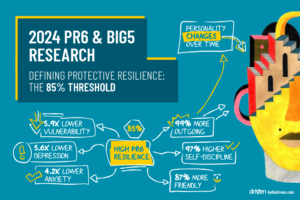Positive motivation techniques in this article can help if:
- You’re feeling unmotivated
- You’re not clear on your goals
- You want to get more done
Jump to:
- What is the definition of positive motivation?
- Positive vs negative motivation
- Positive motivation techniques
- Positive motivation at work
- Positive motivation in sport
- Positive motivation music
What is the definition of positive motivation?
Positive motivation is when a person wants to pursue a certain outcome to gain a reward, instead of to avoid something negative.
For example, working out every day to get a sculpted body is positive motivation, because you’re adding something to your life. However, if you work out every day to avoid feeling bad about yourself, that would be a negative motivation, because you’re subtracting something from your life. In this context, ‘positive’ doesn’t mean ‘good’, but refers to the addition of a thing – and ‘negative’ doesn’t mean ‘bad’, just that you’re subtracting a thing.
Positive vs negative motivation
Positive and negative motivation can both be useful for you to achieve your goals. If your goal has both a carrot and a stick, you have two very good reasons for taking action!
- On the one hand, you may want a promotion or a raise – but on the other hand, you may also want to avoid stagnating in your job or being demoted. Both motivations are wrapped up in the exact same aim.
- There is both a reward and an avoidance of pain in the same goal, and clarifying these will help you stay with personal goals longer.
However, care should be taken when setting goals for others or motivating other people.
- Having only negative motivation – i.e. “Do your homework or you’re grounded” – can sometimes backfire and decrease mental wellbeing and resilience in the long term.
- If you want to motivate a friend, colleague, child, or employee, make sure positive motivation is either the focus, or balanced with the negative: “If you don’t do your homework, I’ll have to ground you for two days, but if you finish it tonight, I’ll read you your favourite story.”
Positive motivation techniques
If you’re looking to increase the amount of positive motivation in your life, or for someone else, focus on creating patterns of reward for behaviour. This will reinforce the behaviour you want to see. Some ideas for positive motivation techniques include:
- List everything that you stand to gain from your particular goal. Having a clear idea of all the positives can be very inspiring! Especially if your goal is more on the negative side, like “avoid failing university”.
- Strength-based focus. Instead of thinking about your weaknesses, consider how you can maximise your strengths.
- Progress chart. Keeping track of progress provides a hit of dopamine when you can see the impact of your actions in real time. Dividing a larger goal into smaller milestones will help with progress.
- Reward yourself. Any way you want! You are your own employee and your own boss. So give the employee side of you decent rewards, and give the boss side a decent return on investment. Incentivise yourself! For instance, give yourself permission to play a video game guilt-free if you do 45 minutes of work.
- Praise and encouragement. Enlist a friend to encourage you for hitting milestones, or even in the middle of a slump.
Apps like Driven can help you build positive motivation. The AI coach increases your resilience and trains motivation techniques. It uses five-minute exercises every day to build an extensive skill set tailor-made for your circumstances.
Positive motivation examples
Positive motivation at work
Employer
If you’re an employer who wants to increase positive motivation in their team, explore ways you can reinforce ideal behaviour and make rewards an everyday part of the culture. You could try some of the following:
- Autonomy. Set a deadline and let your employees figure out how best to achieve it, in any way, time and place that they want to. This will make their task seem more intrinsically valuable, giving them a level of ownership.
- Rewards. Consider what kind of positive reinforcement you can give for doing good work. Perhaps you could let everyone take the mic for a bit each week and report to the whole team about the progress they’ve made. Or maybe you could let your employees go home early if they hit a certain number of tasks. You can call out an employee’s good work publicly or praise them in private.
- Ownership. You can also put your employees in charge of rewarding others, like their assistants or their team (if they’re in charge of one), or pair employees up to be responsible for one other person’s rewards. Get everybody thinking about positive motivation! There are many ways to create an atmosphere of reward in the workplace – it’s just a matter of which will work best for your team.
- Driven provides workplace resilience training designed to help teams develop deep intrinsic reward systems.
Employee
If you’re an employee looking to create positive motivation for yourself, you’re going to have to get creative. You need to build in a reward structure to your work, no matter what kind of work you’re in. Work comes with a built-in negative motivation – you want to avoid losing your job, or not being able to maintain your lifestyle or afford basics. But work also abounds with opportunities to create positive motivation leading to better momentum.
Even if you find your work tedious, there are ways to set up structures to help enjoy the process of getting it done. One of the best things you can do here is to find ways to make your tasks intrinsically rewarding – by rigorous tracking, incorporating it into personal growth, and making your job better. Some ideas:
- Tracking. Everyone can identify with the primal joy of crossing things off a list. You know what makes it easier to cross off a task? Making the task very small. If you need to mark forty papers, make your task to mark only one. Still not motivated? Just read the introduction. Still not motivated? Just put a single paper on your desk. Then cross it off the list. Even the most mundane tasks can become intrinsically rewarding when the end goal is easy to attain. The brain loves to make progress.
- Incorporating work into personal growth. Positive motivation is all about reward – and nothing feels more rewarding than personal improvement. Maybe you want to beat your personal best in some area – like hitting KPIs, moving bricks, or how fast you can calculate a return. Whatever your job, find something about yourself you want to improve and measure yourself against yourself. Every day, turn up and try and beat what you did before.
- Make your job better. Turn it into your personal mission to make your job better for you and everyone else. Is the space looking drab? Slowly add plants. Could your coworkers have better vibes? Start celebrating birthdays and taking them out for coffee. Just not feeling it? Get yourself new work clothes. Use cool notebooks. Brainstorm ways to improve the content of your job. Don’t be afraid to ask the people around you to help with your ideas.
Positive motivation in sport
When it comes to athletes, positive and negative motivation are both present and tangible. Athletes want to win and avoid losing. However, the way in which they act on the positive and negative motivation needs to be carefully thought out to avoid burnout.
A good way to reinforce positive motivation in a healthy way is to focus on intrinsic motivation (i.e. doing something for its inherent value). Studies show that extrinsic motivation (doing something for an external reward) is less effective in the long term. To develop true positive motivation, focus on intrinsic motivation instead of extrinsic.
For example, an Olympian might want to win gold for the money (extrinsic) or purely for the sake of winning (intrinsic). A football player might want to do four more laps because the coach said they would sit on the bench otherwise (extrinsic) or because they value practise for its own sake (intrinsic).
The psychology behind positive motivation
- Human beings are wired to avoid pain and pursue pleasure, though the definition of both is up for debate.
- Rewards help with associative learning and creating desirable behaviours. Rewards activate certain neural pathways, connections and chemicals which make you feel good and increase the chance of repeating the behaviour.
- Marketers and applications can use this power – for example, you have a hit of dopamine when you get a Facebook notification, so you become conditioned to check Facebook more often.
- This is why when you want to change a behaviour, you must first remove the reward. However, you also get a hit of dopamine from going on a run, encouraging you to run more.
Positive motivation music
When all else fails, music can speak to our very hearts and give us new energy. Listening to the right music can be very motivating and create positive motivation.
Look for:
- New, good music that people rave about
- Old, nostalgic music that you loved years ago
- Playlists specific to your task (for example, “songs to clean to”)
- Music by artists you love that you haven’t heard before
Positive motivation is a strong way to create the behaviour you want to see. By incorporating reward into the structure and fabric of your life, you can achieve healthy and long-lasting momentum.



